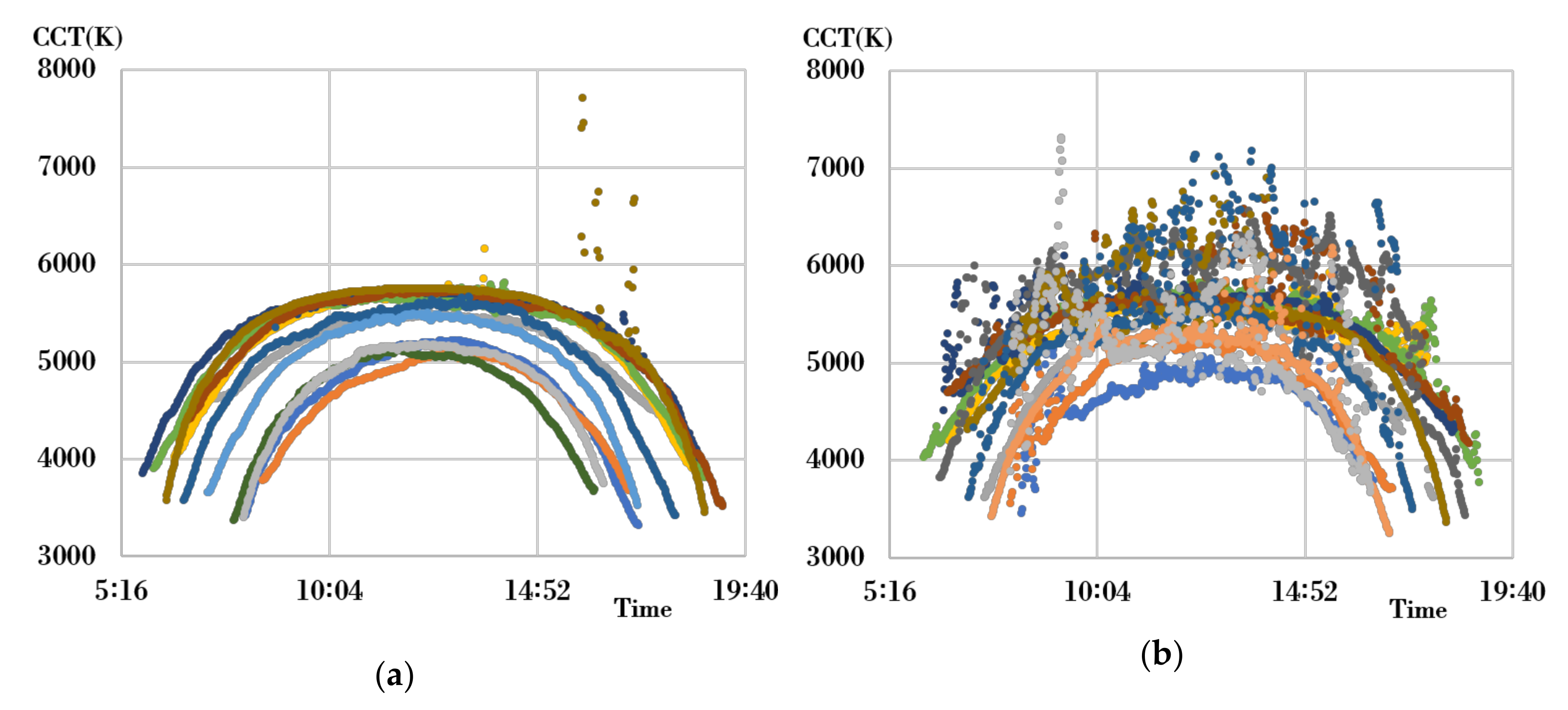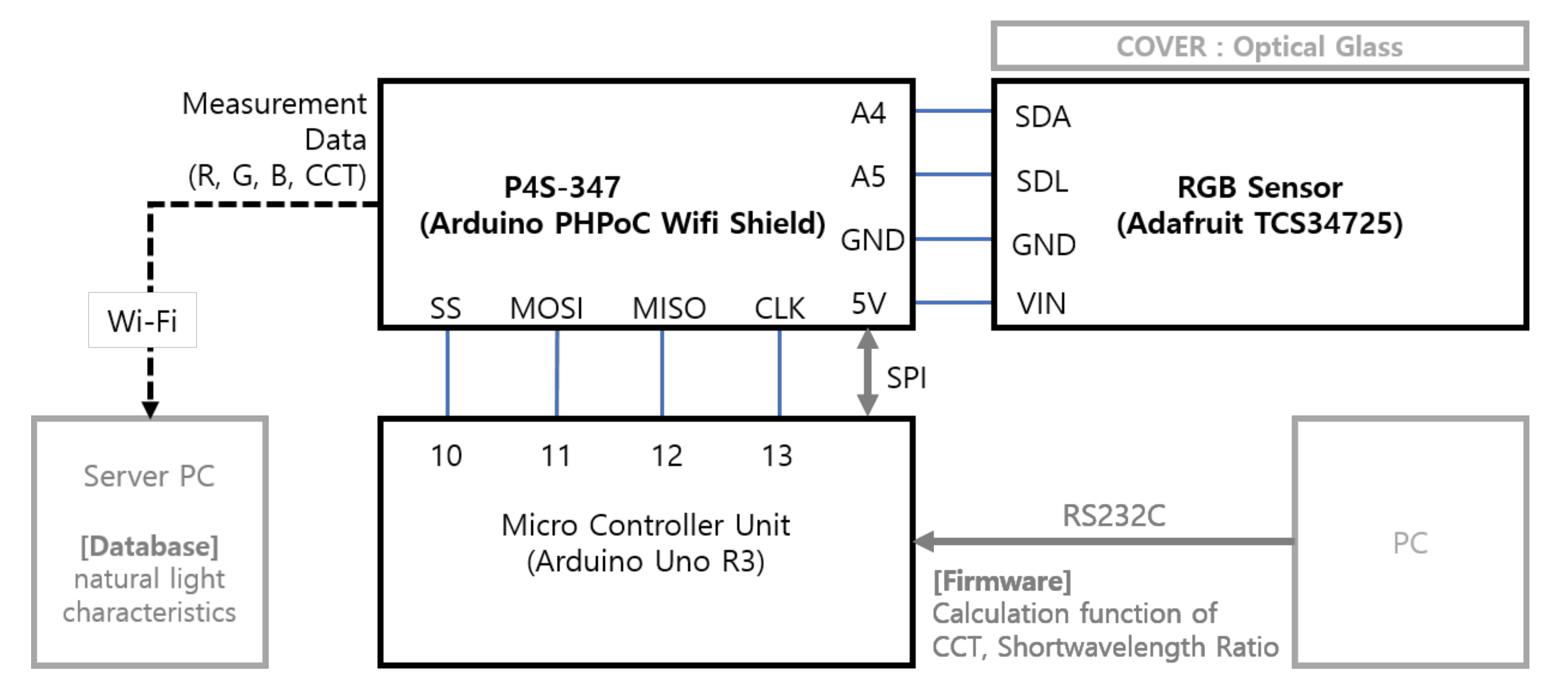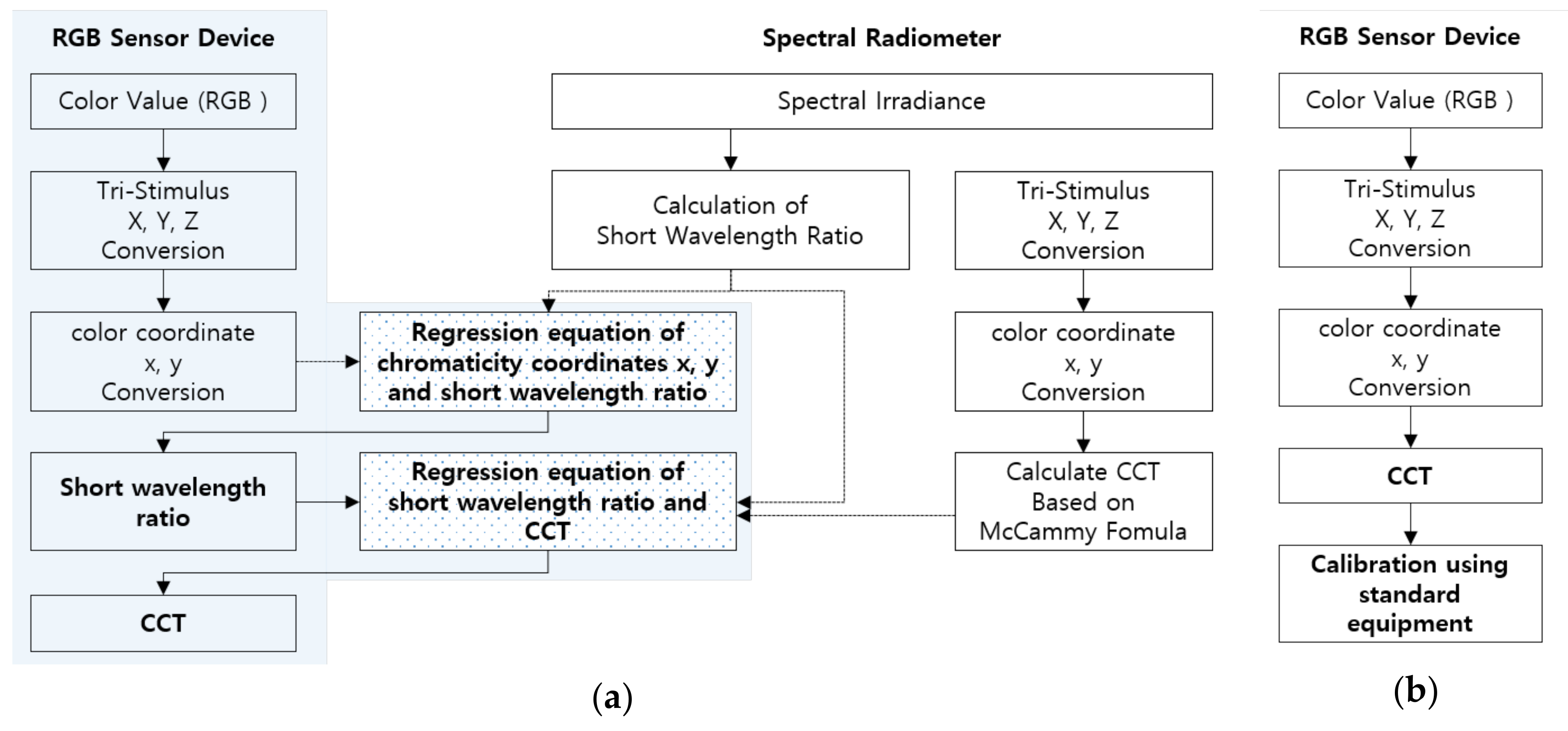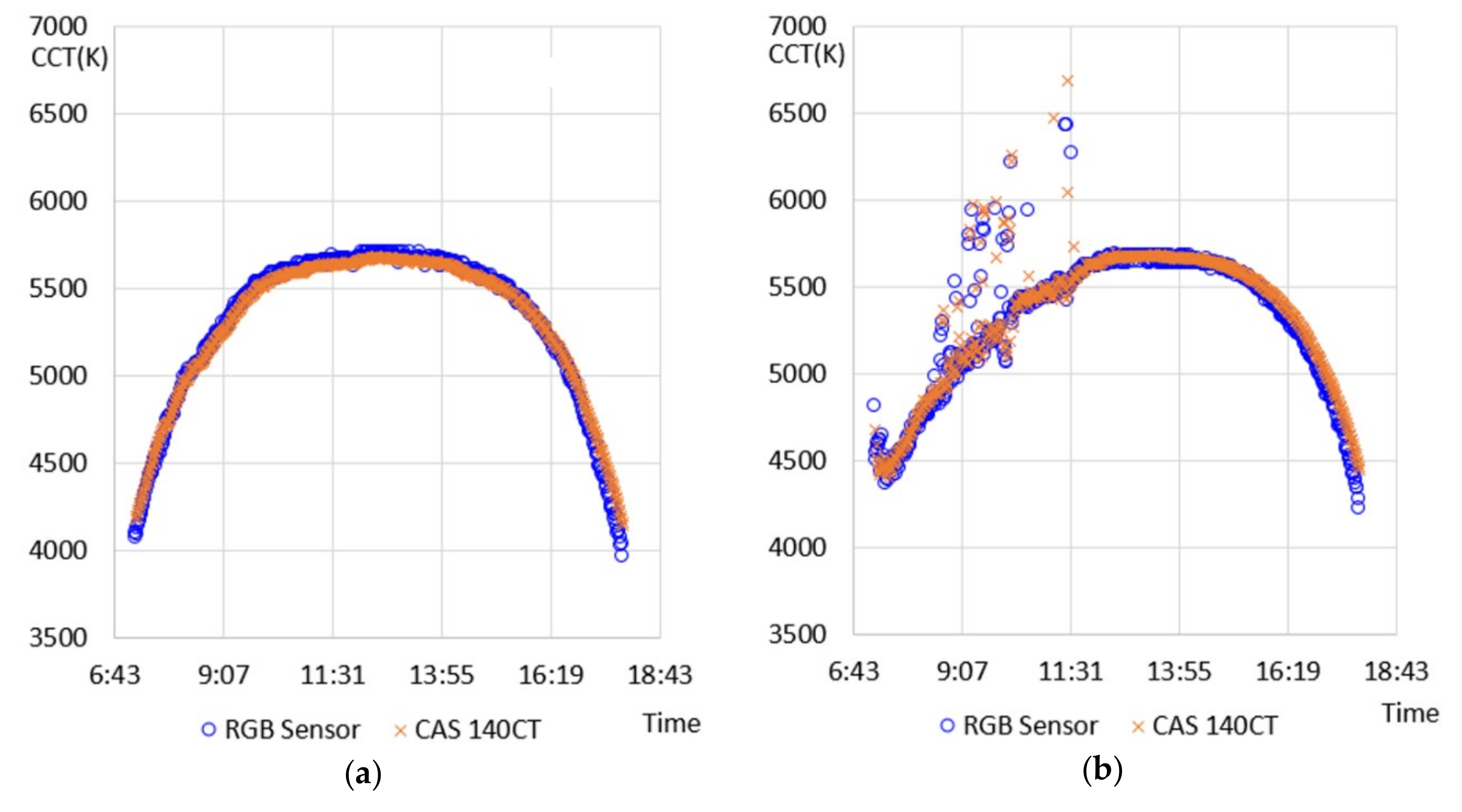Method of Calculating Short-Wavelength-Ratio-Based Color Temperature Supporting the Measurement of Real-Time Natural Light Characteristics through RGB Sensor
Abstract
1. Introduction
2. Characterization of Natural Light
3. A Method for Estimating Color Temperature of Real-Time Natural Light
3.1. RGB-Sensing Device
3.2. Short-Wavelength-Ratio-Based Color Temperature Calculation
4. Experiment and Discussion
5. Conclusions
Author Contributions
Funding
Conflicts of Interest
References
- Knoop, M.; Stefani, O.; Bueno, B.; Matusiak, B.; Hobday, R.; Wirz-Justice, A.; Martiny, K.; Kantermann, T.; Aarts, M.; Zemmouri, N.; et al. Daylight: What makes the difference? Light. Res. Technol. 2019, 52, 423–442. [Google Scholar] [CrossRef]
- Ellis, E.V.; Gonzalez, E.W.; Kratzer, D.A.; McEachron, D.L.; Yeutter, G. Auto-tuning daylight with LEDs: Sustainable lighting for health and wellbeing. In Proceedings of the ARCC Conference Repository, Charlotte, NC, USA, 23 July 2013; pp. 465–473. [Google Scholar]
- Wang, X.X.; Linnartz, J.J.-P. Intelligent illuminance control in a dimmable LED lighting system. Light. Res. Technol. 2016, 49, 603–617. [Google Scholar] [CrossRef]
- Gao, Y.; Cheng, Y.; Zhang, H.; Zou, N. Dynamic illuminance measurement and control used for smart lighting with LED. Measurement 2019, 139, 380–386. [Google Scholar] [CrossRef]
- Trivellin, N.; Meneghini, M.; Ferretti, M.; Barbisan, D.; Lago, M.D.; Meneghesso, G.; Zanoni, E. Effects and exploitation of tunable white light for circadian rhythm and human-centric lighting. In Proceedings of the 2015 IEEE 1st International Forum on Research and Technologies for Society and Industry Leveraging a Better Tomorrow (RTSI), Torino, Italy, 16–18 September 2015; Institute of Electrical and Electronics Engineers (IEEE): Piscataway Township, NJ, USA, 2015; pp. 154–156. [Google Scholar]
- Kim, H.-I.; Kim, J.T.; Yun, G.Y. Evaluation on the lighting performance of a dynamic LED lighting system. J. Korean Sol. Energy Soc. 2011, 31, 113–119. [Google Scholar] [CrossRef]
- Pauley, S.M. Lighting for the human circadian clock: Recent research indicates that lighting has become a public health issue. Med. Hypotheses 2004, 63, 588–596. [Google Scholar] [CrossRef] [PubMed]
- Figueiro, M. A proposed 24 h lighting scheme for older adults. Light. Res. Technol. 2008, 40, 153–160. [Google Scholar] [CrossRef]
- Kim, Y.S.; Kwon, S.Y.; Lim, J.H. Implementation of a Natural Light Chromaticity Coordinates-based Healthy Lighting System. Information 2017, 20, 985–992. [Google Scholar]
- Lockley, S.W.; Brainard, G.C.; Czeisler, C.A. High Sensitivity of the Human Circadian Melatonin Rhythm to Resetting by Short Wavelength Light. J. Clin. Endocrinol. Metab. 2003, 88, 4502–4505. [Google Scholar] [CrossRef] [PubMed]
- Farhud, D.; Aryan, Z. Circadian Rhythm, Lifestyle and Health: A Narrative Review. Iran. J. Public Heal. 2018, 47, 1068–1076. [Google Scholar]
- Rahman, S.A.; Hilaire, M.A.S.; Lockley, S.W. The effects of spectral tuning of evening ambient light on melatonin suppression, alertness and sleep. Physiol. Behav. 2017, 177, 221–229. [Google Scholar] [CrossRef] [PubMed]
- Kim, K.-M.; Kim, Y.-W.; Oh, S.; Lim, J.-H. Development of a natural light reproduction system for maintaining the circadian rhythm. Indoor Built Environ. 2019, 29, 132–144. [Google Scholar] [CrossRef]
- Liu, J.G.; Shen, C.; Shi, J.; Moon, S.; Sun, G. 77-3: Development of CCT Tunable White LEDs for Circadian Lighting. SID Symp. Dig. Tech. Pap. 2018, 49, 1032–1035. [Google Scholar] [CrossRef]
- “Dyson lightcycle” Dyson. Available online: https://www.dyson.com/lighting/task-lighting/dyson-lightcycle/dyson-lightcycle-overview (accessed on 1 October 2020).
- Paus, A.; Hronec, P. The Colour Sensor for Regulation of Tunable White Luminaires. In Proceedings of the 21st International Conference LIGHT SVETLO 2015, Brno, Czech Republic, 08–10 September 2015; pp. 19–23. [Google Scholar] [CrossRef]
- Gentile, N.; Laike, T.; Dubois, M.-C. Lighting control systems in individual offices rooms at high latitude: Measurements of electricity savings and occupants’ satisfaction. Sol. Energy 2016, 127, 113–123. [Google Scholar] [CrossRef]
- Kim, Y.-S.; Seung-Taek, O.; Lim, J.-H. Development of Portable Spectrometer supporting, Automatic Control of Integration Time. Res. J. Pharm. Technol. 2018, 11, 4619. [Google Scholar] [CrossRef]
- Hernández-Andrés, J.; Romero, J.; Nieves, J.L.; Lee, J.R.L. Color and spectral analysis of daylight in southern Europe. J. Opt. Soc. Am. A 2001, 18, 1325–1335. [Google Scholar] [CrossRef] [PubMed]
- Jain, S.; Fernandes, L.; Regnier, C.; Garg, V. Circadian lighting in a space daylit by a tubular daylight device. In Proceedings of the IOP Conference Series: Earth and Environmental Science, Saint Petersburg, Russia, 17–18 April 2019; IOP Publishing: Bristol, UK, 2019; Volume 238, p. 012030. [Google Scholar]
- Valencia, B.J.S.; Giraldo, L.F.E.; Bonilla, V.J.F. Calibration method for Correlated Color Temperature (CCT) measurement using RGB color sensors. In Proceedings of the Symposium of Signals, Images and Artificial Vision-2013: STSIVA-2013, Bogota, Colombia, 11–13 September 2013; IEEE: Piscataway Township, NJ, USA, 2015; pp. 1–6. [Google Scholar]
- Chen, D.C.; Lee, S.W.; Li, Y.H.; Fang, J.Y. Portable Multi-RGB Color Sensor Measurement Device for LED Ceiling Light. J. Huazhong Univ. Sci. Technol. 2011, 49, 49–62. [Google Scholar]
- Beyaz, A. Comparison of arduino based inexpensive colormeters effectiveness at some agricultural, products. Fresenius Environ. Bull. 2017, 26, 6457–6469. [Google Scholar]





| Model (Company) | Image | Specifications |
| CAS 140CT-152 (Instrument Systems) |  | Spectral range (nm): 200–800 Number of pixels: 1024 × 128 Spectral resolution (nm): 2.7 |
| Correlation Coefficient | SWR | MWR | LWR | tristimulus_X | tristimulus_Y | tristimulus_Z | color_coordinate_x | color_coordinate_y | Illuminance | CCT |
|---|---|---|---|---|---|---|---|---|---|---|
| SWR (Short | 1 | −0.993 | 0.923 | 0.929 | 0.931 | 0.956 | −0.99 | −0.996 | 0.931 | 0.997 |
| MWR ( | −0.993 | 1 | −0.961 | −0.931 | −0.933 | −0.942 | 0.998 | 0.982 | −0.933 | −0.993 |
| LWR ( | 0.923 | −0.961 | 1 | 0.885 | 0.886 | 0.86 | −0.963 | −0.896 | 0.886 | 0.928 |
| tristimulus_X | 0.929 | −0.931 | 0.885 | 1 | 1 | 0.987 | −0.921 | −0.914 | 1 | 0.92 |
| tristimulus_Y | 0.931 | −0.933 | 0.886 | 1 | 1 | 0.987 | −0.923 | −0.916 | 1 | 0.922 |
| tristimulus_Z | 0.956 | −0.942 | 0.86 | 0.987 | 0.987 | 1 | −0.931 | −0.948 | 0.987 | 0.948 |
| color_coordinate_x | −0.99 | 0.998 | −0.963 | −0.921 | −0.923 | −0.931 | 1 | 0.981 | −0.923 | −0.991 |
| color_coordinate_y | −0.996 | 0.982 | −0.896 | −0.914 | −0.916 | −0.948 | 0.981 | 1 | −0.916 | −0.992 |
| Illuminance | 0.931 | −0.933 | 0.886 | 1 | 1 | 0.987 | −0.923 | −0.916 | 1 | 0.922 |
| CCT (color temperature) | 0.997 | −0.993 | 0.928 | 0.92 | 0.922 | 0.948 | −0.991 | −0.992 | 0.922 | 1 |
| Correlation Coefficient | SWR | MWR | LWR | tristimulus_X | tristimulus_Y | tristimulus_Z | color_coordinate_x | color_coordinate_y | illuminance | CCT |
|---|---|---|---|---|---|---|---|---|---|---|
| SWR (Short | 1 | −0.994 | 0.922 | 0.279 | 0.289 | 0.433 | −0.991 | −0.992 | 0.289 | 0.991 |
| MWR ( | −0.994 | 1 | −0.958 | −0.305 | −0.315 | −0.449 | 0.994 | 0.979 | −0.315 | −0.984 |
| LWR ( | 0.922 | −0.958 | 1 | 0.358 | 0.368 | 0.467 | −0.946 | −0.887 | 0.368 | 0.908 |
| tristimulus_X | 0.279 | −0.305 | 0.358 | 1 | 1 | 0.981 | −0.263 | −0.24 | 1 | 0.184 |
| tristimulus_Y | 0.289 | −0.315 | 0.368 | 1 | 1 | 0.983 | −0.273 | −0.25 | 1 | 0.194 |
| tristimulus_Z | 0.433 | −0.449 | 0.467 | 0.981 | 0.983 | 1 | −0.411 | −0.401 | 0.983 | 0.341 |
| color_coordinate_x | −0.991 | 0.994 | −0.946 | −0.263 | −0.273 | −0.411 | 1 | 0.987 | −0.273 | −0.985 |
| color_coordinate_y | −0.992 | 0.979 | −0.887 | −0.24 | −0.25 | −0.401 | 0.987 | 1 | −0.25 | −0.985 |
| Illuminance | 0.289 | −0.315 | 0.368 | 1 | 1 | 0.983 | −0.273 | −0.25 | 1 | 0.194 |
| CCT (color temperature) | 0.991 | −0.984 | 0.908 | 0.184 | 0.194 | 0.341 | −0.985 | −0.985 | 0.194 | 1 |
| Part | Name | Specification |
|---|---|---|
| Color Sensor | Adafruit TCS34725 RGB Sensor | Sensing factor: red, green, blue, clear light sensing values; 3 × 4 photodiode array with IR-Blocking Filter; Measurable range: 0 to 65,535 for each RGB Channel Operating free-air temperature: −30–70 °C |
| MCU | Arduino Uno | Microcontroller: ATmega328P |
| WiFi Shield | P4S-348 | PHPoC Shield for Arduino WLAN; topology: Ad-hoc, Infrastructure, Soft AP |
| Diffuser | Ground Glass | Diameter (mm): 10.00 ± 0.25; Thickness (mm): 1.60; Wavelength Range (nm): 350–2000 |
| Classification | RGB-Sensor-Based Color Temperature Measuring Device | Standard Equipment (Spectroradiometer, CAS 140CT) |
|---|---|---|
| Instrument and output factors | Illuminance, RGB, tristimulus values (X, Y and Z), chromaticity coordinates (x and y), color temperature (CCT) | Spectral irradiance, wavelength band-by-band (short, middle and long wavelengths) ratios, illuminance, RGB, tristimulus values (X, Y and Z), chromaticity coordinates (x and y), color temperature (CCT) |
| Color Temperature (K) | Short-Wavelength Ratio (%) | |||||||
|---|---|---|---|---|---|---|---|---|
| Date | Time | (a) Standard EquipmentCAS 140CT | (Existing Method) RGB-Sensor-Based Measuring Device | (e) (Proposed Method) Short -Wavelength Ratio-Based Calculation | Standard EquipmentCAS 140CT | Proposed Method | ||
| (b) Experimental Test Result (before Calibration) | (c) Color Temperature Calibration | (d) Chromaticity Coordinate-Based Calibration | ||||||
| 20.04.04 | 7:12 | 4681.87 | 6239.528 | 4265.26 | 3835.808 | 4807.789 | 16.64 | 16.85 |
| 20.04.04 | 7:13 | 4588.73 | 5815.352 | 4118.533 | 3773.164 | 4540.031 | 16.14 | 15.06 |
| 20.04.04 | 7:14 | 4518.28 | 5770.384 | 3953.319 | 3414.759 | 4501.389 | 15.76 | 14.80 |
| 20.04.04 | 7:15 | 4490.18 | 5910.468 | 3993.026 | 3649.885 | 4595.391 | 15.61 | 15.43 |
| 20.04.05 | 9:30 | 5388.59 | 7266.202 | 5376.623 | 5375.491 | 5402.430 | 21.70 | 20.82 |
| 20.04.05 | 9:31 | 5397.74 | 7328.484 | 5410.156 | 5408.558 | 5428.375 | 21.75 | 20.99 |
| 20.04.05 | 9:32 | 5410.07 | 7275.929 | 5381.86 | 5380.783 | 5406.809 | 21.82 | 20.85 |
| 20.04.05 | 9:33 | 5415.24 | 7275.929 | 5381.86 | 5380.783 | 5406.809 | 21.86 | 20.85 |
| 20.04.07 | 12:00 | 5459.03 | 7406.134 | 5451.963 | 5451.212 | 5463.187 | 22.52 | 21.23 |
| 20.04.07 | 12:01 | 5464.97 | 7442.926 | 5471.771 | 5472.471 | 5481.808 | 22.55 | 21.35 |
| 20.04.07 | 12:02 | 5470.72 | 7438.425 | 5469.348 | 5470.011 | 5479.863 | 22.58 | 21.34 |
| 20.04.07 | 12:03 | 5471.18 | 7429.341 | 5464.457 | 5465.046 | 5475.929 | 22.59 | 21.31 |
| 20.04.08 | 14:30 | 5628.06 | 7697.476 | 5608.821 | 5624.914 | 5619.363 | 23.26 | 22.27 |
| 20.04.08 | 14:31 | 5627.67 | 7798.847 | 5663.399 | 5681.245 | 5661.600 | 23.26 | 22.55 |
| 20.04.08 | 14:32 | 5626.42 | 7795.272 | 5661.474 | 5679.316 | 5660.274 | 23.25 | 22.54 |
| 20.04.08 | 14:33 | 5623.91 | 7726.041 | 5624.201 | 5641.772 | 5633.810 | 23.23 | 22.37 |
| 20.04.09 | 15:00 | 5427.2 | 7325.481 | 5408.539 | 5412.959 | 5440.796 | 22.09 | 21.08 |
| 20.04.09 | 15:01 | 5467.1 | 7386.821 | 5441.564 | 5448.513 | 5472.803 | 22.31 | 21.29 |
| 20.04.09 | 15:02 | 5506.61 | 7364.482 | 5429.537 | 5436.442 | 5463.224 | 22.50 | 21.23 |
| 20.04.09 | 15:03 | 5526.2 | 7423.004 | 5461.046 | 5468.895 | 5490.104 | 22.63 | 21.41 |
| 20.04.24 | 18:08 | 4171.02 | 5253.462 | 4292.964 | 4274.232 | 4151.222 | 13.12 | 12.47 |
| 20.04.24 | 18:09 | 4150.36 | 5345.677 | 4342.612 | 4321.42 | 4220.916 | 12.98 | 12.93 |
| 20.04.24 | 18:10 | 4122.84 | 5421.814 | 4383.605 | 4359.967 | 4276.069 | 12.82 | 13.30 |
| 20.04.24 | 18:11 | 4102.23 | 5345.801 | 4342.679 | 4319.52 | 4218.038 | 12.68 | 12.91 |
| Average error rate (%) | 34.06% | 1.112% | 1.138% | 0.903% | - | 5.31% | ||
| Standard deviation on error rate (%) | 4.73% | 1.78% | 1.77% | 1.62% | - | 3.09% | ||
Publisher’s Note: MDPI stays neutral with regard to jurisdictional claims in published maps and institutional affiliations. |
© 2020 by the authors. Licensee MDPI, Basel, Switzerland. This article is an open access article distributed under the terms and conditions of the Creative Commons Attribution (CC BY) license (http://creativecommons.org/licenses/by/4.0/).
Share and Cite
Oh, S.-T.; Jeon, G.-W.; Lim, J.-H. Method of Calculating Short-Wavelength-Ratio-Based Color Temperature Supporting the Measurement of Real-Time Natural Light Characteristics through RGB Sensor. Sensors 2020, 20, 6603. https://doi.org/10.3390/s20226603
Oh S-T, Jeon G-W, Lim J-H. Method of Calculating Short-Wavelength-Ratio-Based Color Temperature Supporting the Measurement of Real-Time Natural Light Characteristics through RGB Sensor. Sensors. 2020; 20(22):6603. https://doi.org/10.3390/s20226603
Chicago/Turabian StyleOh, Seung-Taek, Geon-Woo Jeon, and Jae-Hyun Lim. 2020. "Method of Calculating Short-Wavelength-Ratio-Based Color Temperature Supporting the Measurement of Real-Time Natural Light Characteristics through RGB Sensor" Sensors 20, no. 22: 6603. https://doi.org/10.3390/s20226603
APA StyleOh, S.-T., Jeon, G.-W., & Lim, J.-H. (2020). Method of Calculating Short-Wavelength-Ratio-Based Color Temperature Supporting the Measurement of Real-Time Natural Light Characteristics through RGB Sensor. Sensors, 20(22), 6603. https://doi.org/10.3390/s20226603




